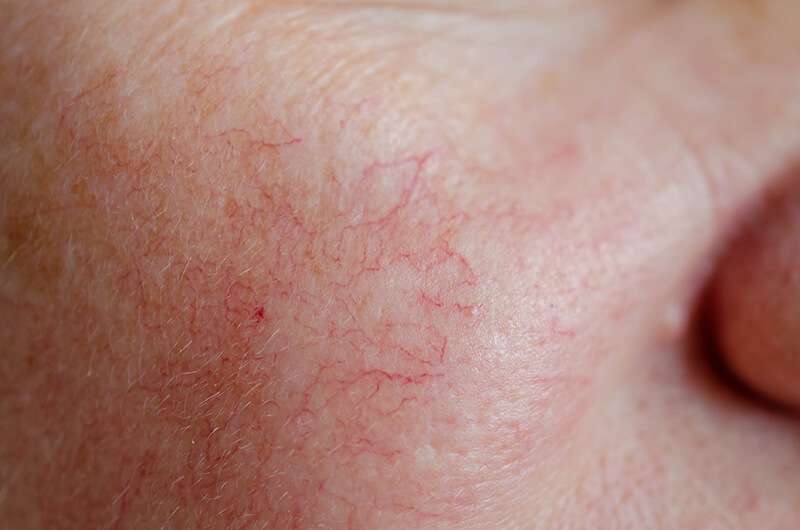This term is a very broad way to describe blood vessels, veins, capillaries or redness in the skin. For most of us, we can’t stand to see the vessels in our face, in our legs or in our body.
So, why do they appear?
Let’s start with the face. The correct term for any blood vessels we see on our face is TELANGIACTASIA (pronounced – tel-angie-act-asia). As for the more general flushed pinky-red appearance, we call this DIFFUSED REDNESS.
The most common causes for these are:
- Excessive sun exposure
- Frequent hot showers/hot baths/saunas etc
- Excessive alcohol consumption
- Smoking
- Poor diet
- Thinned skin/loss of collagen
- Inflammation
Not so common causes for these are:
- Allergies & intolerances
- Prolonged use of improper skin care
- Result from trauma/impact/cosmetic or surgical treatment
- Medical conditions/medications
- Pressure from weightlifting
How can telangiectasia and diffused redness be treated?
Typically, the most effective and long-lasting way to treat is with Laser photocoagulation. This means the laser coagulates the blood within the vessel whilst simultaneously causing destruction to the walls of the vessel. After 2+ weeks the treated vessel is broken down and removed. The result is fewer to no visible vessels and even skin with less redness.
Treatments that should be avoided include microdermabrasion, ablative or fractionally ablative laser, medium to deep chemical peels and aggressive micro-needling. These will likely have no effect and can exacerbate the condition.
Other forms of vascularity on the face includes Rosacea, post-inflammatory erythema, angiomas and spider nevi. Let’s look at these conditions separately.
Rosacea is categorized as an incurable inflammatory skin condition which includes permanent diffused redness and telangiactasia in a butterfly type pattern across the cheeks and down the nose, lip and chin and may also feel quite warm. Rosacea is commonly accompanied by small non-pustular bumps that come up quickly and also go down quickly (within 3-7days). In some cases, Rosacea can be accompanied by pustular acne type breakouts and in severe cases a thickening of the skin on the nose with a rough/bumpy appearance and texture. Sometimes those with Rosacea find it difficult to find skin care that works for their skin without irritation.
The exact cause of Rosacea is still unknown however there are several aspects to this condition that researchers are aware of and actively looking for a cure.
Treatment for Rosacea should include a dedicated gut health program (diet & supplements if needed), Laser photocoagulation, gentle chemical peels, gentle LED therapy, gentle face massage (lymphatic is great for acne-rosacea) and non-irritating skin care regime.
Post-inflammatory erythema is a term given to any pinky-red marks that are a result of trauma where inflammation was present. For example, permanent pinky-red marks from acne, skin grazes, deep cuts, stitches or burns. PIE is always flat unless there is scar tissue present which can be either raised or indented. Treatment includes laser photocoagulation, superficial chemical peels, gentle micro-needling and LED therapy.
Angiomas and spider nevi are clusters of blood vessels causing a round, red (sometimes raised) spot about 1-5mm in diameter. Spider nevi (aka spider angiomas) have vessels protruding from the spot giving it a spider like appearance. The most effective treatment for these is laser photocoagulation.
Now for the body.
While most vascular conditions mentioned above can also affect the body (not including Rosacea), there are some conditions that only affect the body.
Poikiloderma is a vascular and pigmented condition which comes up around mid-life on the neck & decolletage. It includes a mottled brown appearance with diffused redness and many tiny telangiactasias. The number 1 cause is excessive sun exposure. Treatment includes removal of pigment with lasers or peels followed by removal of the redness with laser photocoagulation. Some lasers can do the pigment and vascularity at the same time.
Lastly, unsightly leg veins can cause a lot of distress for those who are unfortunate enough to get them. Not only does the appearance of leg veins affect a person’s confidence, they can be painful too.
Common causes for leg veins are:
- Frequent prolonged standing or sitting
- Result from trauma (eg. Impact, frequent bruises, cosmetic or surgical procedure)
- Pregnancy or weight gain
- Inflammation
- Medical conditions/medications (eg. poor blood pressure or circulation)
- Pressure from weightlifting
So how can leg veins be treated?
Just like a tree, our vascular system has a few big, long, deep vessels (logs), and several smaller thinner superficial vessels coming off (branches). The large, deep, bluey-green vessels are called reticular veins and are found around the backs of the legs and sometimes on the front. The smaller red or purplish vessels are telangiectasia (like the ones mentioned at the start). The reticular veins need to be treated first as in a lot of cases the smaller vessels will drop away when the feeder vein is no longer supplying blood. While there are many treatments that claim to be effective, by far the most popular and long-lasting treatments are laser photocoagulation or sclerotherapy. Both procedures aim to cause destruction of the reticular veins and minimize or remove the smaller telangiactasia.

